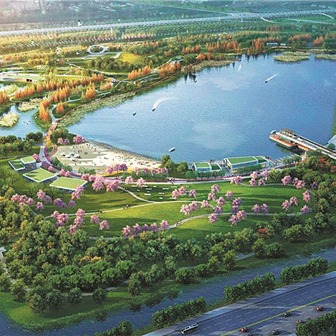




One of the first things about Shanghai that Lee Parks says he liked when he first settled down in the city's Pudong New Area in 2004 was "green planning".
Despite being a new district which started rapid development only since the 1990s, city authorities had not forgotten about the importance of nature in planning the new area.
Parks says he noticed countless trees were being planted in communities, parks and streets.
"Twenty years on, those trees and parks are maturing, and I now see a city with increasingly valuable ecological resources," says Parks, the head of landscape at the Shanghai Office of the American infrastructure consulting firm AECOM.
"We now have shaded sidewalks because tree canopies have matured. The ecological habitat and wildlife species are increasing in diversity every year. I really have seen changes and benefits happen in Shanghai."
But Parks wasn't just a witness to this improvement of the city's ecology-he was a part of it. In the past five years, the Briton has been involved in the planning of more than a dozen large-scale parks and green spaces that have contributed to the diversity of the city's landscapes.
One of the most important projects for Parks and a team of ecologists and water specialists at AECOM was the second phase of the Binjiang Forest Park, which is located at the city's northern edge of Wusongkou, where the Huangpu River meets the Yangtze River.
The opening of the site's first phase was in 2007. Parks and his team proposed creating more space for activities in the 114-hectare Phase II area in a designing competition in 2015.
"We learned that people like to go to parks to have barbecues. But such activities are in conflict with the very nature of an ecological conservation area, a place where you want wildlife to thrive, not to be disturbed," he says.
The design team also proposed rerouting the main road to better protect a 100-year-old tree at the site, and elevating the road so that an underground passage connecting two parts of the park for wildlife, one of the most notable being the Chinese Water Deer, could be created.
"At AECOM, we see the future landscape of Shanghai as inclusive, high-quality, well-governed, ecological and interconnected, and this allows for the creation of a truly global city that supports its citizens and wildlife," says Parks.
Today, Shanghai has 406 parks, a forest coverage of 18.49 percent and the area of public green spaces per capita is 8.5 square meters, according to the municipal landscaping and city appearance bureau. But the city is still eyeing improvement.
In July, the municipal government announced the Thousand Parks Plan with the aim of increasing the number in the city to more than 1,000 by 2025, and 2,000 by 2035.

"Compared with London, New York and Singapore, the current scale and quality of green spaces in Shanghai still has room to improve," says Deng Jianping, director of the bureau.
"We plan to make greenery a soft power of the city's core competitiveness."
According to the city's 14th Five-Year Plan (2021-25), green spaces will be constructed along the city's outer Ring Road and eight "green wedges" will be built. Four of them, namely Senlan, Biyun, Sanlin and Zhangjiabang, will be completed by 2025, while the construction of the rest will be pushed forward as well.
The city's green trail will be extended along rivers to create public spaces and ecological corridors. A total of 1,000 kilometers of green trail will be added in the next five years. In the suburbs, the trail will run along forest strips. In downtown areas, it will run along the riverbanks.
Besides enhancing a project that turned 87 km of embankment along the Huangpu River and Suzhou Creek into leisure spaces over the past five years, the plan also includes green waterfront construction along rivers such as the Chuanyang and Dianpu and Zhangjiabang.
Deng says, "Shanghai aims to become a park city, a forest city and a wetland city, and foundations for those long-range objectives will be laid soundly by 2025."
Parks' team at AECOM has also participated in the landscape planning of Zhangjiabang Green Wedge, which consists of large green spaces along the 23.5-km Zhangjiabang River that connects the Huangpu River and the East China Sea.
According to the final plan released by the Pudong district government, the construction of the wedge-shaped green space was split into multiple phases, and the total area of green spaces and water bodies will cover more than 600 hectares, twice the size the Central Park in New York.
"Our vision is to create large continuously connected areas for people to enjoy along the riverside without having to crossover major roads," says Parks.
"I hope that people can one day run and cycle along the Zhangjiabang, from the Huangpu all the way to the East China Sea and back," he says.
"That will be a great 50-km route."
If you have any problems with this article, please contact us at app@chinadaily.com.cn and we'll immediately get back to you.